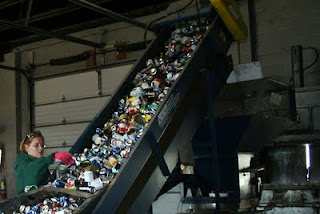
While most well-meaning consumers intend to recycle their home steel products, it wouldn’t be possible without the tens of thousands of curbside and drop-off locations across the nation. Knox County Recycling Center in Mount Vernon, OH has been in operation for over ten years accepting steel food and beverage cans, aerosol cans, scrap steel and several other types of materials.
While there are curbside programs in the area to compliment the convenience of this facility, the Knox drop-off location remains active as ever.
Steel products are a staple of any recycling program and Knox County Recycling Coordinator Linda Montgomery says it’s because of how easy the process is.
“It is extremely easy to operate and fun to watch. Steel and aluminum cans are recycled together and piled onto a large conveyor belt that rises overhead. When the cans are at the end of the conveyor belt, all the aluminum cans drop off into a large pile or pit ready to be bailed; the steel cans are propelled across the opening by a large magnetic strip, after the leap the steel cans land on another conveyor belt and head to a second bailer. Both bailers have the ability to crush the cans and then wire the bale together. The bales are loaded into a semi and are ready to be shipped away and melted down to begin the remanufacturing process.”
According to the Steel Recycling National Recycling Database there are currently over 7,700 curbside programs across the United States which provide recycling to over 164 million citizens while there are almost 13,000 drop-off locations. Both of these recycling options are vital to keeping steel as North America’s #1 most recycled material and Linda acknowledges that.
“Recycling steel saves 75 percent of the energy that would be used to create steel from raw materials,” Linda continued. “Steel has been recycled for 150 years and most steel structural beams and plates are made from almost 100% recycled steel.”
She does, however, see an advantage in drop-off locations.
“The advantage of drop-off locations is willing participation,” she stated. “People who have invested time to drive to a drop-off are serious about recycling and do a good job [preparing materials]. Curbside participants put out anything they think they can recycle.”
She went on and also stated how curbside programs require the route to be run twice – once for garbage and trash and again for recyclables, which ties up manpower and equipment.
“Drop-off locations are so important to the community,” she concluded. “The average person will drive three miles out of their way to recycle so the more convenient it is the greater the chance of getting someone to recycle.”
The convenience of 24 hour drop-off availability goes hand-in-hand with the simplicity of curbside pickup. Luckily most Americans don’t have to choose and can utilize both options for their steel recycling needs.

